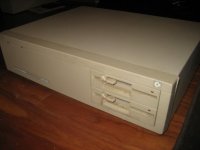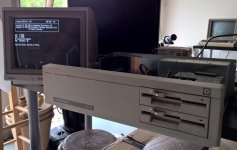sgifanatic
Experienced Member
I just bought a Commodore PC-10 8088 system from eBay. It hasn't arrived yet, but here are some pics from the listing:


The details were fairly scarce, but I think I got it for a good price, and most importantly, the seller reports that the system powers up and operates.
The insides are fairly bare. From a picture, I was able to figure out that the graphics card is an ATI Hercules board. Specifically, this one:
ATi Graphics Solution Rev 3
Chipset: ATI CW16800-A
Supports: Hercules Graphics Card mode
Port: 8-bit PC/XT bus
There appears to be a RAM expansion board also, shown below:

And in the same picture, you can see that the processor bears the NEC logo, but sadly, it's not a V20. Rather, a D8088D. There's really not much else other than 2x5.25 drives, a 25-pin serial port and a parallel port.
I've ordered a few additional items so that they arrive at about the same time this system does, and I can start to play with it:
1) An Intel 8/16 Etherexpress LAN card. I like this because it can be repurposed in 16-bit ISA systems, and it has an RJ-45 connector.
2) 25-pin female to 9-pin male serial adapter
3) Microsoft serial mouse 2.0
4) 5.25 floppy disks... I had run out!
5) XT-2-PS/2 keyboard adapter
I am looking to add an 8087 and upgrade to a V20. Here are the chips I've found. Are these a good idea? Is a V30 a better idea?
V20 Listing: http://www.ebay.com/itm/1pcs-D70108...ion-DIP-V20HL-V30HL-16-8-16-BIT-/251349355121
8087 Listing: http://www.ebay.com/itm/1pcs-D8087-1-D8087-CDIP-40-Arithm-etic-Processor-INTEL-/181384867819
Also, I want to add a hard drive, a color graphics card (VGA? CGA?) card and a sound card. But all three upgrades appear to be quite pricey, well above $50 each, and in some cases, twice that. Any tips on less expensive options? Specific cards that might be in more plentiful supply, for example?
One of my motivations in getting the XT is so that I can run Trixter's various 8088 demos. However, domination requires a VGA, while mph requires a CGA... do I have to get both?
Will share pics and a project log when the system arrives. Thanks in advance for any advice!


The details were fairly scarce, but I think I got it for a good price, and most importantly, the seller reports that the system powers up and operates.
The insides are fairly bare. From a picture, I was able to figure out that the graphics card is an ATI Hercules board. Specifically, this one:
ATi Graphics Solution Rev 3
Chipset: ATI CW16800-A
Supports: Hercules Graphics Card mode
Port: 8-bit PC/XT bus
There appears to be a RAM expansion board also, shown below:

And in the same picture, you can see that the processor bears the NEC logo, but sadly, it's not a V20. Rather, a D8088D. There's really not much else other than 2x5.25 drives, a 25-pin serial port and a parallel port.
I've ordered a few additional items so that they arrive at about the same time this system does, and I can start to play with it:
1) An Intel 8/16 Etherexpress LAN card. I like this because it can be repurposed in 16-bit ISA systems, and it has an RJ-45 connector.
2) 25-pin female to 9-pin male serial adapter
3) Microsoft serial mouse 2.0
4) 5.25 floppy disks... I had run out!
5) XT-2-PS/2 keyboard adapter
I am looking to add an 8087 and upgrade to a V20. Here are the chips I've found. Are these a good idea? Is a V30 a better idea?
V20 Listing: http://www.ebay.com/itm/1pcs-D70108...ion-DIP-V20HL-V30HL-16-8-16-BIT-/251349355121
8087 Listing: http://www.ebay.com/itm/1pcs-D8087-1-D8087-CDIP-40-Arithm-etic-Processor-INTEL-/181384867819
Also, I want to add a hard drive, a color graphics card (VGA? CGA?) card and a sound card. But all three upgrades appear to be quite pricey, well above $50 each, and in some cases, twice that. Any tips on less expensive options? Specific cards that might be in more plentiful supply, for example?
One of my motivations in getting the XT is so that I can run Trixter's various 8088 demos. However, domination requires a VGA, while mph requires a CGA... do I have to get both?
Will share pics and a project log when the system arrives. Thanks in advance for any advice!


